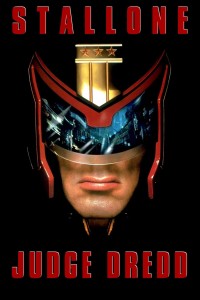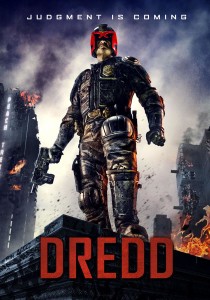Review: Judge Dredd (1995) vs Dredd (2012)
Remakes seem very in fashion in recent years, and Dredd is but one of many. As is usual for me, I only tend to write reviews when I feel I have something particular to say about a piece of fiction (whether it is on screen or page).
I was late to the Dredd train, sadly missing it on the big screen and only picking it up when I saw it randomly on sale in the store. Once I got it home, I thought I’d amuse myself by watching the previous incarnation of the character on screen – Judge Dredd with Sylvester Stallone as the titular character – followed by the newer movie. It turned out to be an interesting contrast; they are very different movies.
(Note: I don’t read the 2000 AD comics that the character of Dredd is originally from, so won’t compare to the original source much. I’ll stick to what I know of the comics – the broad strokes – and leave the details to those who know more about that side of things than me.)
Honestly, the two movies are so different that it is hard to compare them. I enjoyed them both a lot, but for very different reasons. Could I pick a favourite? Probably not!
When I think about comparing these two movies, I have to say that it’s easier to say what was the same than what was different. The main character – the inimical and intimidating Judge Dredd – is there, his uniform and equipment are similar, it’s set in a city of the same name, and there’s an important relationship with a female Judge in it. Beyond those things, however, they are almost completely different.
Let’s start with the big picture. They are both action flicks, but where Judge Dredd injects humour to lighten the load, Dredd is quite prepared to makes friends with the bloody dark and take you down into it. The 1995 movie is much more what I tend to refer to as an action romp, the kind you go into knowing you’re going to be entertained and probably grinning half the time. The 2012 movie, however, doesn’t pretend to be anything as light as entertainment: it’s gritty, violent, and doesn’t shy away from the downright nastiness and ruthlessness of the world the Dredd is trying to police.
Personally, I don’t see either of these things as more or less than the other: the movies have very different tones and seem to have set out to be very different beasts.
The plot of the movies couldn’t be more different, too. The scope is vastly different (and here I’m going to get very spoilery – you have been warned).
In Judge Dredd, the plot is so broad that it threatens the stability and order of the entire city/metropolis/megapolis (it’s the size of a small country), with world-shaping ramifications. There are secrets and twists in the plot, peeling back layers of conspiracy to reveal villains in places they’re not supposed to be. It also delves deeply into the main character’s background, raising (and answering) fundamental questions about who Dredd is and where he came from.
Dredd himself goes on a sweeping character arc, as he has to deal with being stripped of his Judge-ship (yes, that is a word, shh) and exiled from the city he dedicated his life to protecting and serving. He also has to deal with the ramifications of the revelations about his origin, a close personal betrayal, and the unbending of the stick up his ass. Long story short: he’s a changed character by the end of the movie.
Dredd, on the other hand, has a much narrower focus. We’re shown the situation in Mega-City through the lens of a single residential building. Granted, it’s a huge building, but almost the entire movie occurs within its walls. The villain is known from the start, there aren’t any real surprises as far as motives go (only a pretty minor betrayal, shown as an instance of corruption), and the plot is much more of a straight line compared to Judge Dredd‘s squiggling journey.
Dredd is a concentrated look at what daily life is like for these Judges, and shows just how dangerous and almost futile their position is. It doesn’t have anything like the breadth of vision of the earlier movie, and it doesn’t seem to need it.
With such a focussed plot, Karl Urban’s character journey can’t go anywhere near the heights and troughs that Stalone’s Dredd did. Instead, it’s quite the opposite: Urban’s Dredd is pretty much the same man walking out of the movie as he was going in. You don’t learn much about him or his background; you learn about what a badass he is and he has a shift of opinion about the rookie he’s mentoring through the war zone they’re trapped in, but that’s about it.
Normally, this would bother me (the lack of character arc is a big problem for me in Kill Bill). In this case, though, it doesn’t. It fits the movie, and it fits the kind of character that Dredd is. Anderson, Dredd’s rookie companion, goes through a metamorphosis and she has a distinct character arc, so the movie isn’t devoid of growth. It’s through the lens of her that we see into Dredd and it’s because of her that he shows some loosening of his grimness at the end.
For me, Dredd felt like the pilot to a new TV series. And let me tell you, I’d watch the shit out of that show. The movie was a slice of life, a glimpse into a huge world with a lot of scope and story just waiting for someone to film and give us. Don’t get me wrong: it was a complete story in itself, but I was definitely left with an enthusiasm for more.
Judge Dredd was definitely a movie in scope and story. The story packed in there was enough for a TV show to spend a season or two unpeeling for us. It didn’t leave a lot of room for more to follow. This isn’t necessarily a bad thing; it’s just different.
Earlier, I mentioned that both movies involve a relationship with a female Judge. Even this manages to be a difference between the movies.
In Judge Dredd, that relationship winds up becoming romantic (at the very, very end). The woman in question, Hershey, is a fully-qualified and battle-proven Judge, very much on a par with Dredd. It works because of the journey that Dredd has gone through by that point, both in himself and with Hershey.
In Dredd, the female Judge is the rookie he’s escorting for her first day on the streets (Anderson). The dynamic between them is quite different to that between other-Dredd and Hershey: here, he’s in the role of mentor, superior to Anderson, and she is established early on as a sub-par Judge recruit, promoted to the streets on the merits of the psychic abilities she has. Through the movie, Dredd moves from dark pessimism about her ability to survive the day to grudging respect, but at no point does it sniff anywhere near romance (or lust).
I found the lack of romance a relief. The default behaviour of movies to demand a romantic plot is tiresome, particularly action movies where the hero has to get the girl as if he needs that to be truly manly. Sometimes it fits the feel and plot of the movie, sometimes it’s a natural outcome for the characters, and that’s all good. But too often, it is shoehorned in as an afterthought. It wouldn’t have fit in Dredd for many reasons, and they didn’t force it. I applaud this decision. (I had the same reaction to the end of Pacific Rim for the same reason.)
I suppose you can’t talk about Judge Dredd and not mention the helmet. I remember when the 1995 movie came out, and the outcry from comic fans because Stalone removes the iconic helmet (and he’s without it for a lengthy swathe of the story). Apparently, this Does Not Happen Ever in the comics. I’m sure the fans were greatly relieved that Urban didn’t remove the helmet once, not even a glimpse of the man beneath the mantle of Judge beyond his constantly down-turned mouth.
It’s a big metaphor about the character of Dredd and what the movies did with him, but I’ve already talked about the respective character arcs, so I won’t hammer it again. You get the idea.
I guess I should talk about the cinematography of the movies, too. I’m no film technician or expert, so this will be brief, but even my amateur eyes noticed a few things worth mentioning.
In Judge Dredd, the breadth of the story is such that the visuals and aesthetic have a wide range, from scifi city and hover-bikes, to desert and dust, to rusted chains and a hovel in a cave. It’s pretty standard 90s scifi fare.
In Dredd, the focus is much narrower but that doesn’t make the visuals any less stunning. In fact, the aesthetic of the movie seems more crafted for the world it’s depicting and does a lot more work than the visuals in the 1995 movie.
It feels like they worked even harder to make the most of what was a fairly limited canvas, and you definitely get the gritty, grubby, hard atmosphere that is life in Mega-City. In comparison, the slow motion glimpses of the Slo-Mo drugged state are oddly terrifying and beautiful, diamonds against a dirty backdrop. Which is, of course, why that drug is so popular.
I find it curious that the same source material has produced such different movies. I haven’t even got to mention the comedic element that Rob Schneider brought to Judge Dredd, or the darkness of Lena Headey (of Game of Thrones fame) as Ma Ma in Dredd.
Even after all this consideration, I can’t pick a favourite from the two; it comes down to what mood I’m in. I still hope that they make a sequel to Dredd, though. I think there’s more (darkness and) fun to be had there.
Comments are closed!

